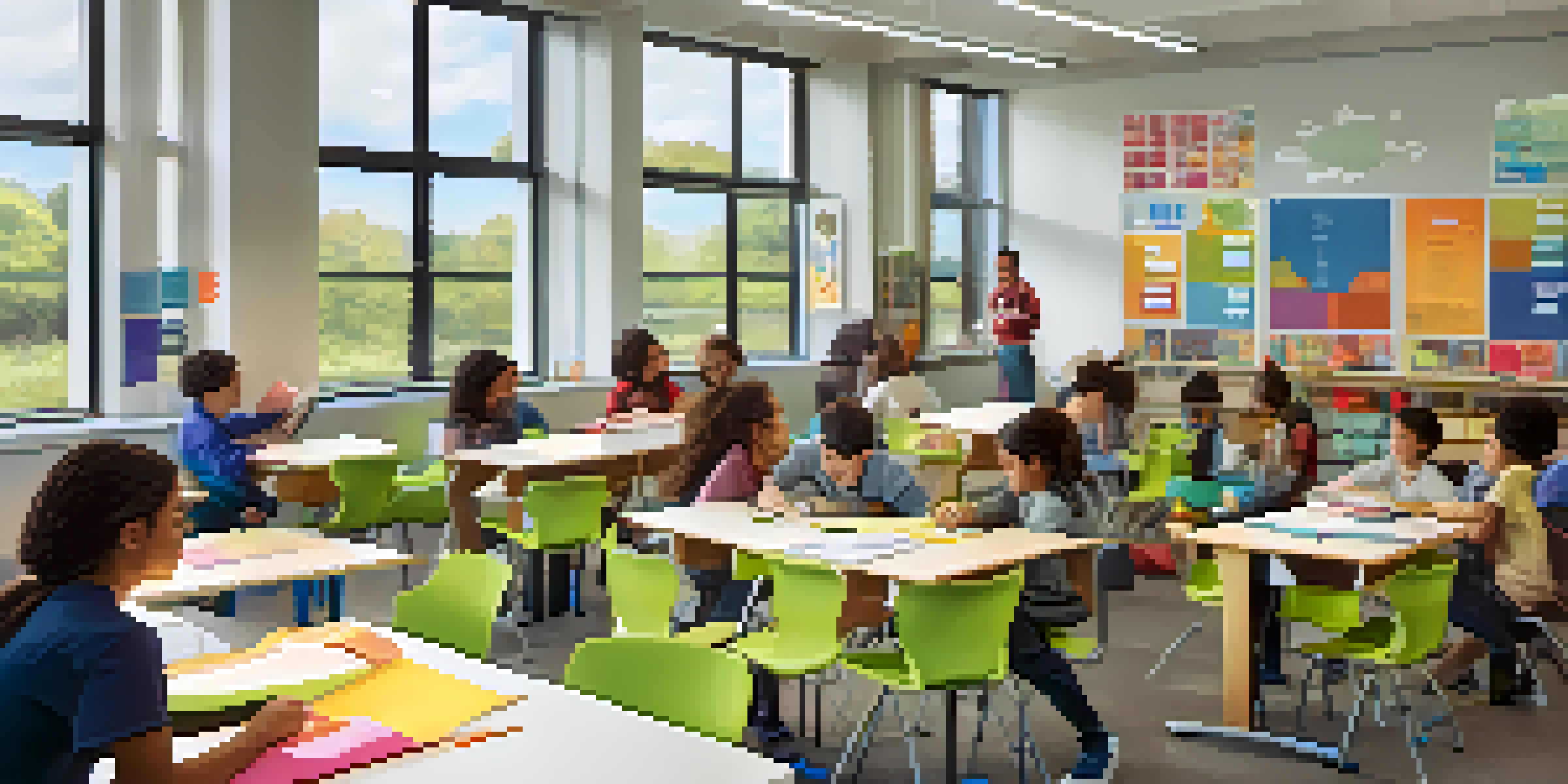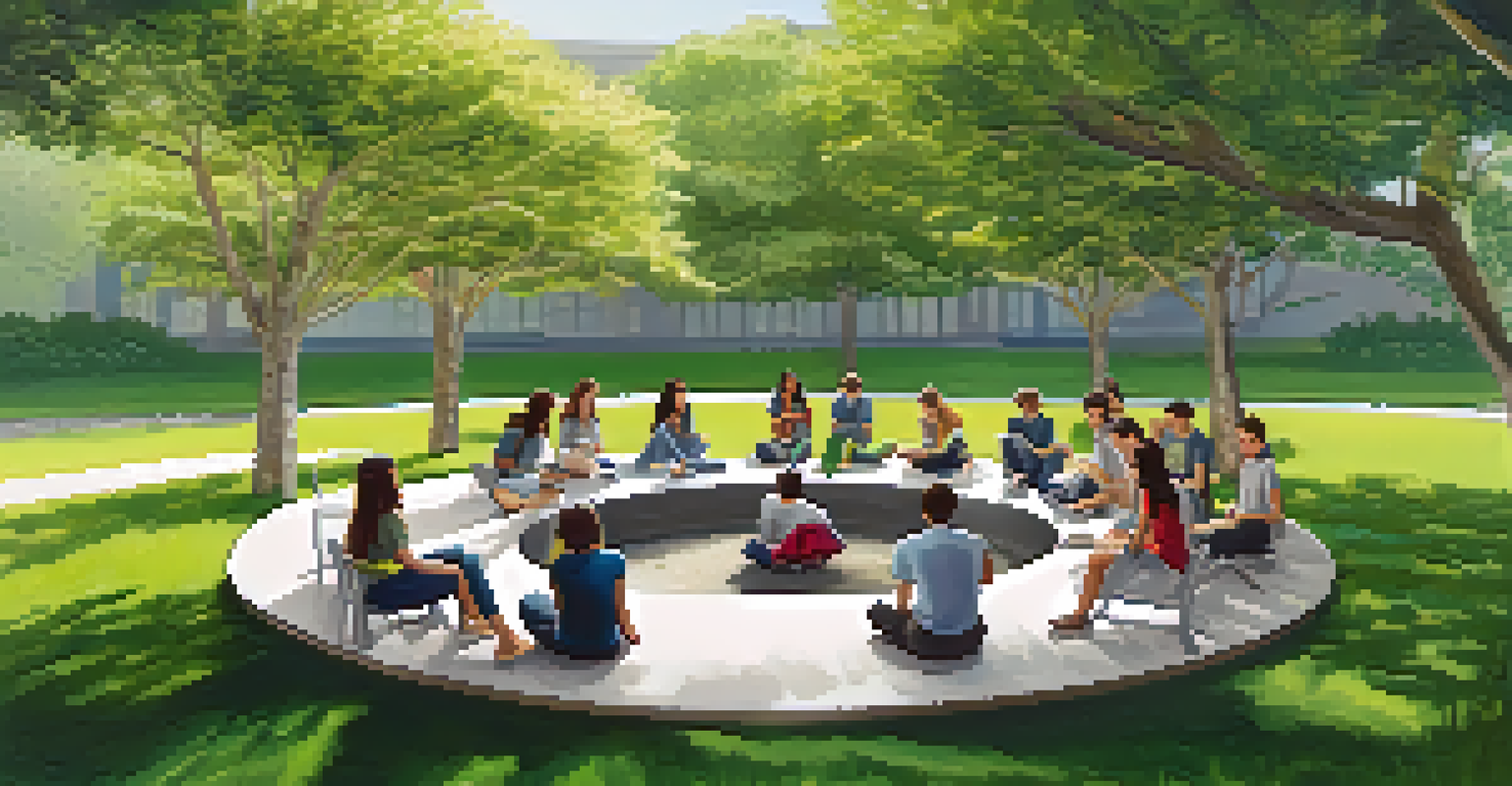Flexible Furniture: A Key to Modern Learning Spaces

Understanding Flexible Furniture in Learning Spaces
Flexible furniture refers to adaptable pieces that can be easily rearranged to suit various learning activities. In modern education, this concept has taken center stage as schools and universities aim to create environments that foster collaboration and creativity. Just think of it as a chameleon—able to change its form to fit its surroundings, enhancing the learning experience.
The furniture we choose for our classrooms can profoundly impact the way students learn and engage with each other.
These furniture pieces can range from movable desks and chairs to modular seating arrangements that can be reconfigured for different teaching styles. For instance, a classroom with traditional desks may limit group work, while flexible seating allows for a more dynamic interaction among students. This adaptability not only supports different learning modalities but also encourages students to take ownership of their space.
Moreover, flexible furniture is not just about mobility; it’s about creating an atmosphere that promotes engagement and comfort. By allowing students to choose their seating arrangements, they can find what works best for them, enhancing focus and participation. This approach reflects a shift towards student-centered learning, where the environment plays a crucial role in educational success.
Benefits of Flexible Furniture in Education
One of the primary benefits of flexible furniture is its ability to support diverse learning styles. For example, kinesthetic learners thrive in environments where they can move around, while visual learners benefit from collaborative spaces that encourage group projects. By accommodating these various styles, educators can create more inclusive classrooms that cater to every student’s needs.

Additionally, flexible furniture promotes collaboration among students. Imagine a class where students can easily rearrange their desks for group discussions or presentations. This not only fosters teamwork but also helps students develop essential communication skills that are vital in today’s world. The ease of movement encourages spontaneous discussions, leading to richer learning experiences.
Flexible Furniture Enhances Learning
Adaptable furniture supports diverse learning styles and fosters collaboration among students.
Lastly, flexibility in furniture design can contribute to improved classroom management. With the ability to rearrange spaces quickly, teachers can adapt their environments for different activities, whether it’s a lecture, a workshop, or a group project. This adaptability helps maintain student interest and attention, making the learning process more engaging and effective.
Designing Flexible Learning Spaces
Designing a flexible learning space involves more than just choosing the right furniture; it requires a thoughtful approach to layout and functionality. Educators and designers should consider the activities that will take place in the space and select furniture that enhances those activities. For instance, lightweight tables can be easily moved, allowing for quick transitions between individual and group work.
Flexibility is the key to stability.
Moreover, incorporating technology into flexible learning spaces can further enhance their functionality. Desks with built-in charging ports or collaborative screens can make group work more efficient and engaging. By integrating technology seamlessly with flexible furniture, schools can create environments that prepare students for a tech-driven future.
It’s also essential to consider the aesthetic aspects of flexible learning spaces. A well-designed space that is visually appealing can significantly impact student motivation. Bright colors, natural lighting, and comfortable seating can all contribute to a welcoming atmosphere that encourages students to engage with their learning.
Challenges of Implementing Flexible Furniture
While the benefits of flexible furniture are clear, implementing these solutions isn’t without its challenges. One of the main hurdles is budget constraints, as high-quality, adaptable furniture can be more expensive than traditional options. Schools must balance their desire for modern learning environments with financial limitations, often leading to difficult decisions about priorities.
Another challenge is the need for professional development for educators. Teachers must be trained to effectively use flexible furniture in their teaching methods. Without proper guidance, even the best-designed spaces can fall short of their potential. Ongoing training and support are crucial to ensure educators feel confident in leveraging flexible learning environments.
Design Matters for Engagement
Thoughtful design of learning spaces, including aesthetics and technology integration, boosts student motivation and participation.
Lastly, there may be resistance to change from both educators and students who are accustomed to traditional classroom setups. Transitioning to a more flexible arrangement requires a cultural shift within the school community, which can take time. However, with clear communication about the benefits and ongoing support, this transition can lead to a more dynamic and engaging learning experience.
Case Studies: Schools Embracing Flexibility
Many schools around the world have embraced flexible furniture to enhance their learning environments. For example, a progressive school in Finland transformed its traditional classrooms into open spaces filled with movable furniture, leading to increased student engagement and collaboration. Teachers reported that students were more eager to participate in group discussions and projects, showcasing the positive impact of flexible design.
Another inspiring case is a school in the United States that integrated flexible seating arrangements into its curriculum. By allowing students to choose where and how they sit, the school noticed a significant improvement in student focus and satisfaction. This initiative not only transformed the physical space but also positively influenced the school’s overall culture.
These case studies illustrate that when schools invest in flexible furniture, they can create dynamic learning environments that cater to the diverse needs of students. As more educational institutions recognize the benefits of flexibility, we may see a broader shift towards innovative, adaptable learning spaces across the globe.
The Future of Flexible Furniture in Education
The future of flexible furniture in education looks promising as more schools recognize the importance of adaptable learning environments. With advancements in design and materials, we can expect to see even more innovative solutions that cater to the evolving needs of students and educators. This evolution will likely include furniture that incorporates technology and sustainability, aligning with modern educational values.
Additionally, as remote and hybrid learning models continue to grow, the concept of flexible furniture will expand beyond traditional classrooms. Schools may explore outdoor learning environments or community spaces that support flexible arrangements, encouraging students to learn in diverse settings. The adaptability of furniture will become even more critical in these varied environments.
Challenges in Implementation
Budget constraints and the need for educator training can hinder the adoption of flexible furniture in schools.
Ultimately, the continued emphasis on flexible furniture in education reflects a broader shift towards personalized learning. As educators strive to create spaces that empower students, flexible furniture will play a crucial role in fostering an engaging and effective learning experience. The future is bright for adaptable learning spaces, and it’s exciting to envision what lies ahead.
Conclusion: Embracing Flexibility for Better Learning
In conclusion, flexible furniture is more than just a trend in modern education; it’s a vital element that enhances learning experiences. By creating adaptable spaces that support various learning styles and promote collaboration, schools can foster an environment where students thrive. The benefits extend beyond the classroom, equipping students with skills essential for success in the real world.
While challenges exist in implementing flexible furniture, the positive outcomes seen in schools that embrace this concept are undeniable. With careful planning, professional development, and community support, educational institutions can overcome these hurdles and create spaces that inspire creativity and engagement.

As we move forward, it’s crucial for educators, designers, and policymakers to prioritize flexible furniture in their plans. By doing so, we not only prepare students for a dynamic future but also create a culture of adaptability that will serve them well throughout their lives. Embracing flexibility in learning spaces is indeed a key to unlocking the potential of every student.